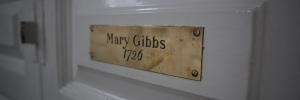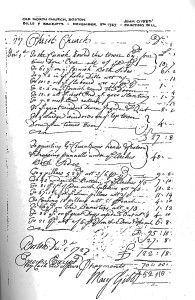The People in the Pews: Mary Gibbs
By Amy Budge
With additional information added by the Old North Education Department
“With an extension of her allusion religious activities can be seen as a means used by New England women to define self and find community, two functions that worldly occupations more likely performed for men.” – Nancy F. Cott, The Bonds of Womanhood
 Forever stamped on the brass plate of Pew No.8, the name Mary Gibbs stands out amongst the merchants and sea captains. With a view of the altar better than some men could afford, the question “who is this woman?” begs for an answer.
Forever stamped on the brass plate of Pew No.8, the name Mary Gibbs stands out amongst the merchants and sea captains. With a view of the altar better than some men could afford, the question “who is this woman?” begs for an answer.
At a time when gender and wealth determined a person’s social standing, it seems particularly out of place that a woman was able to procure a seat of prominence so early in the church’s history. Perhaps it was religious devotion that drove her to desire such a place in the church, or perhaps it was the chance to publicly display the power she secretly wielded in her home.
For Mary Gibbs and other women of the colonial period, religion was a way to express the self in a world where the female opinion was often disregarded as simple and unimportant. The public space was not an appropriate venue for the voices of women to be heard, despite what may have been happening in the private home. The church represented a middle ground of sorts; neither the mercantile world of husbands nor the domestic sphere of wives. Women were viewed as being exceptionally pious and their input was more often than not taken into consideration within church communities.
Mary Gibbs was married to John Gibbs, and their son John, Jr. contributed a significant amount of time to the painting of the church. John Gibbs, Sr. was one of the first vestry members and had an established relationship with the church’s first reverend, Dr. Timothy Cutler. Mary was widowed not long after her husband purchased Pew No. 8. In his will, Gibbs stated that Reverend Cutler was to receive 10 pounds of the estate, while his four children were only to receive 5 pounds.
 The preconceived notion that women were not suited to the demands of handling estates remains just that. Mary Gibbs was named sole benefactor and executor of the will, most likely due to the fact that she was well accustomed to handling her husband’s accounts. Church records indicate that she documented the contributions of her husband to the church and signed off on all of the bills and receipts. She followed up on debts and made sure that her husband was paid what he was owed. Managing an inheritance was simply second nature to her.
The preconceived notion that women were not suited to the demands of handling estates remains just that. Mary Gibbs was named sole benefactor and executor of the will, most likely due to the fact that she was well accustomed to handling her husband’s accounts. Church records indicate that she documented the contributions of her husband to the church and signed off on all of the bills and receipts. She followed up on debts and made sure that her husband was paid what he was owed. Managing an inheritance was simply second nature to her.
Mary Gibbs’ name also appeared in the church records in relation to the people she enslaved. From records of baptisms, marriages and funerals, we know that Mary owned at least three or four enslaved persons. In 1736 and 1737, Henry and Susanna, respectively, were baptized and are listed as “servants” of Mary Gibbs. Church records also tell us that two other people enslaved by Mary, Henry and Peter, married enslaved people from other households in 1737.
There is no doubt that Mary Gibbs was devoted to her church and valued church participation. Her purchase of the pew emphasizes the rare opportunity for a woman to publicly display her independence and wealth. But it also cannot be ignored that this independence and wealth she enjoyed was directly connected to her enslavement of others.
